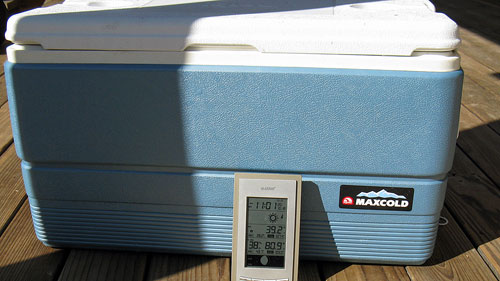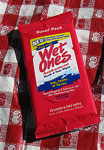Food safety is an often overlooked discipline when it comes to family camping in the backcountry. At least until somebody gets sick, that is. Most food poisoning is caused by bacteria, which is in the soil, air, water, and the foods we bring camping with us. In small quantities these bacteria are harmless, but when conditions are right the bacteria can rapidly increase in number to a point where they can cause illness.
When it comes to camping food safety, the big challenge is keeping perishable food at 40-degrees, or lower. Bacteria can grow rapidly at temperatures between 40 and 140 degrees and there are no tell-tale signs of dangerous bacterial growth, such as taste, smell or discoloration.
Most of us are familiar with food spoilage, which is easy to spot (or smell!) when our food gets old, but spoilage is caused by a completely different type of bacteria than the kind that causes food poisoning (called “pathogenic bacteria”). Spoilage is usually not a problem for most campers, because our camping trips are relatively short.

The best defense against an outbreak of pathogenic bacteria in camping food is a good ice chest with a lot of ice. I have tested our 70-quart Igloo® MaxCold™ ice chest, on an 80-degree summer day, to find out how much ice it takes to keep the internal temperature at 40-degrees. I initially tested with two milk jugs (I make my own block ice with 1-gallon milk jugs), which could only keep the ice chest at 45-degrees. Next, I switched to three milk jugs and this seemed to do the trick, keeping the cooler between 38 and 42 degrees throughout the afternoon.
Different types and sizes of ice chests will perform differently, however, so it pays to test your own. All you need is a way to measure the inside temperature, preferably without opening the lid. I used our weather gauge, which has remote sensor for measuring the outside temperature – I just placed this sensor on top of the food, inside the ice chest.
 Another challenge we all face when camping is cleanliness. Everything that comes into contact with food should be clean. This usually means a lot of antiseptic wipes and waterless hand cleaner, unless you have ready-access to tap water in the campground.
Another challenge we all face when camping is cleanliness. Everything that comes into contact with food should be clean. This usually means a lot of antiseptic wipes and waterless hand cleaner, unless you have ready-access to tap water in the campground.
Something that we find extremely beneficial is to prepare much of our camping food ahead of time, at home, and freeze it. It’s much easier to deal with individual frozen hamburger patties at the campsite, than several pounds of raw hamburger and the associated mess that creates. In addition, the frozen foods work with the ice to help control the temperature in our cooler.
See also…

It’s really easy to give yourself food poisoning using the ice cubes in your cooler for drinks, because juices from meats, etc. can contaminate the cubes. That being said, ice does work better for cooling stuff than the blue ice, because when ice melts, it makes cold water, and water has excellent heat transfer properties comparied to solid things like blue ice. (sorry to nerd out, but I am an engineer!) That’s why, if you ever need to cool down a bottle of wine quickly, the fastest way is to fill up a bucket with ice water and it will cool it down really quick!
The bottom line, to me, is that blue ice is the most food safe way to go.
I like to use the “blue ice” freezer packs because they are much more easier to fit in a cooler than frozen water. I also like the idea someone said earlier about freezing whatever food ahead of time that you can. That really works well. We always seem to need ice cubes while camping – to make ice cream, for drinks, etc. So we usually buy a bag of ice at the campground, and we keep it in it’s own smaller cooler that’s just for ice.
I always wondered how those “blue ice” packets perform vs. block ice. Ice cubes are a pain, but we use them sometimes for ice cream and drinks.
Hey Roy,
Good Tips! Another tip I like to follow/share is to fill old gallon and half gallon milk jugs with water and freeze that to use those as my ice source. This keeps the melted ice from getting into everything and then spreading bacteria to all of my food. I would hate to say, “Salmonella flavored potato salad anyone?” 🙂
Cheers,
Jason
Thanks, Jason – milk jugs are a great way to make your own ice, if you have the freezer space!
One of my favorite fast camping foods with minimal cleanup required is fajitas. I marinate chicken breasts, slice them up and store them in a big Ziploc baggie along with sliced onions and bell pepper. They are pretty quick to cook up when you arrive at the campsite and then you just roll them up in tortillas. No need for plates or silverware for that first night. If there are leftovers put them in the cooler and mixed them into scrambled eggs the next morning for fantastic breakfast burritos!
If you cook the fajitas in foil packets….nothing to wash! That’s what I do…
And foil packet cooking is just cool 🙂
Definitely a great meal for camping. We use a griddle on the campfire and throw the skirt steak and peppers on there – just scoop them up with a spatula and load a tortilla 🙂
Great post – everyone needs this info.
Eric
New Jersey Campgrounds
Thank you, Eric! I hopefully fixed your link – let me know if that’s not the right site.
I like the freezing method. I freeze everything that is freezable. I’m all about double duty, so the fact that it keeps other food cold and is edible is great. You just have to time it right so everything isn’t frozen when the crew is starving!
It’s worked well for us, Mel. I’d say a bigger challenge is what to eat that first evening, if you’re just going away for a quick weekend trip. We need something super easy and quick to prepare, since we’re usually getting to the campsite just before sundown.
I think people don’t wash dishes by hand well when they have to heat up the water themselves. Here’s a great Girl Scout camping rule that everyone would benefit from – have a final rinse of the dishes with water with a small amount of bleach in it.
Oh no kidding? I didn’t know that – I use bleach and water to periodically clean all of my water containers and my hydration pack. I’m used to it from the Army days, when all the water tasted like bleach 🙂
Not sure why, but I seem to be more concerned about food safety at home than once I’m outdoors. Something that would cause me to pitch food at home won’t even cause me to pause when camping. Fell on the floor, pitch it. Fell in the dirt, brush it off and throw it in the pan! Cooler low on ice? Its still relatively cool, should be ok! I will say that, now that I take the kids with me, the outdoor standard isn’t quite as liberal, but its still more so than when I’m at home. Wonder if its just me, or if other people loosen their standards when outdoors?
I bet a lot of us are guilty of that, Marc. And clean-up, let’s face it – there’s not a lot of “hot soapy water” out there in the woods (at least not with the way my kids go through water!).
Good points. It’s always a good reminder to stay safe, especially with food. Keep away from wildlife too! Like Bears!
I’ll take the bears – just give me some relief against those raccoons! 🙂
Great ideas and advice! Most people know about mayo based foods but forget everything else. We are so used to popping things in and out of refrigerators that food safety isn’t something most folks think about.
They mayo thing – that was huge when I was growing up. I think since then, they’ve figured out that mayo is actually less susceptible to microbial contamination that other dairy products.